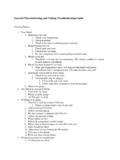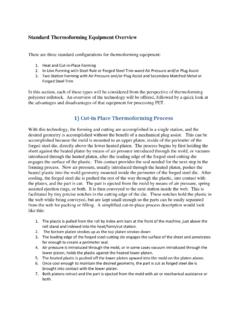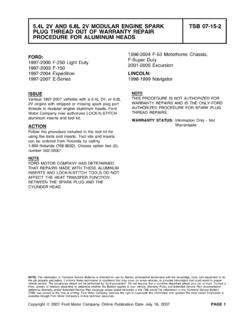Transcription of Modular Two-Station Forming With Matched …
1 Modular Two-Station Forming with Matched metal Trim This is a simplified drawing of a Modular Two-Station thermoforming process featuring Matched metal trimming. Two-Station thermoforming has the most flexibility and can be used to produce parts from general purpose thermoforming grades like PET to engineering grades of plastic and other difficult to form plastics like CPET. The Two-Station process is similar to in-line equipment except that it features a separate trim station . This type of process almost exclusively utilizes Matched metal trim dies, but forged steel or steel rule can also be used if desired. Because the trim station is autonomous, and not slaved to the same stroke as the Forming station , a six-cavity mold can be trimmed by a two cavity Matched metal die by running a faster cutting stroke.
2 The Two-Station process looks like this: station one 1. Plastic is pulled off the roll by a roll feed fixture at the front of the machine, just after the roll stand, and is fed into the pin chain rails where it is held by its edges, and indexed into the oven 2. In the oven the sheet is heated, preferably from both sides, until it reaches the desired temperature for thermoforming 3. The machine indexes and the heated plastic, still held by its edges on the pin chain, is carried into the Forming station , and a new length of plastic is moved into the oven 4. Once the plastic is at station , the upper and lower platens move together. The heated plastic is formed by a combination of the mold and the plug assist, and the effect of vacuum and air pressure.
3 Once the formed plastic is cool enough, the upper and lower platens open. 5. The machine indexes and the formed parts exit the pin chain and are transported to the independent trim station . The plastic is conveyed to the trim press on an arched shaped guide. station two 1. Plastic is pulled into the cutting station by indexing arms that push on an indexing lug formed into the plastic. 2. Cutting is accomplished by the combined action of upper and lower platens. Usually, there is a close tolerance Matched metal punch and die assembly doing the cutting. The platen speed and cycle time are independent from the cycle time of the Forming station . 3. The parts are then stacked and packed in containers for shipping 4.
4 The waste web is either wound into a coreless bale, or pulled into a grinder for recycling. Advantages The Matched metal thermoforming process is used to form almost every type of plastic used in the packaging industry. It is extremely versatile and may be modified and configured in many ways and is the ideal machine for long running items. The cutting die has a longer life expectancy than steel rule and forged steel dies, and once adjusted and broken in, will cut parts with great consistency for the life of the die. This type of equipment can run as much as 35%. faster than in-line equipment running similar parts. Disadvantages The main disadvantages of this process are up-front cost, new part development cost, change over cost, and set up cost.
5 Troubleshooting Guide 1. Forming Defects 2. Poor Detail 1. Material is too cold 1. Check oven temperature 2. Check heat time 3. Check to be sure circulating pump is running 2. Form Pressure too low 1. Check seals and vents 2. Check hoses for leaks 3. Be sure compressor and vacuum pump are functioning 3. Plastic is too hot 1. The plastic is cloudy due to overheating. The cloudy condition is caused by heat induced crystallinity 4. Plastic has been heated for too long 1. Time and temperatures under 190 degrees Fahrenheit will induce crystallinity that is transparent and will make the sheet very stiff 5. Inadequate seal in tool or sheet clamp 1. Check hoses and seals for leaks 2.
6 Vacuum hole may be plugged 1. Clean mold and clear vents 2. Probe vents after texturing to clear obstructions 6. Sheet over gauge 3. Too Much or unwanted Detail 1. Vent holes too large 2. Plastic is under gauge 3. Air Pressure too high 4. Webbing or bridging 1. Material is stalling instead of flowing 1. Plastic or mold surface may be too cold 2. Adjust timing of Forming 3. Adjust vacuum timing 4. Be sure vacuum is adequate and effective 5. Adjust Air pressure timing 6. Platen speed too fast 7. Failure in temperature control system 8. Blown fuse to thermocouple or controller, bad wire 9. Index length too short 10. Adjustment in zone heating profile needed 11. Thin spot in the plastic 12.
7 Perimeter sheet clamp failure 5. Distorted geometry or warped parts 1. Cooling time too short 1. Part coming off mold too hot 2. Surface temp of mold too warm 1. Increase coolant efficiency through turbulence inducing inserts 2. Be sure water circulating pump is running 3. Insufficient cooling to the mold 1. Heat transfer inefficient between mold and cooling plate 1. Consider improving efficiency by redesigning and eliminating the cooling plate 2. Water circulating pump has not kicked off 4. Part is hanging up on mold during ejection 1. Scrapes and wrinkles are observed 5. Air pressure too low 1. Check to be sure air eject ports in mold are not plugged 2. Make sure hoses are not kinked or cut 3.
8 Check status of compressor 6. Dents or wrinkles in parts 1. Part is sticking to the mold 1. Mold surface may need maintenance 2. Platens opening too fast 3. Air eject ports may be obstructed 4. Timing adjustment in air eject cycle needed 5. Air eject pressure too high 1. Bottom of part is caved in or wrinkled 6. Inadequate clearance for parts in trim die relief or stacker 7. Chain rails out of synchronization side-to-side or out of parallel 8. Sheet advancing before parts clear the mold 9. Parts hit an obstruction during conveyance 10. Stacker needs adjustment 7. Poor material distribution 1. Adjust mold temperature 1. Mold surface usually too cool 2. Surface temp of mold inconsistent 2.
9 Adjust form air timing 3. Adjust vacuum timing 4. Adjust platen speed 5. Thickness of plastic out of specification 6. Sheet temperature inconsistent 1. Check heat zone temps 2. Adjust heat zone profile 7. Plug geometry or plug timing needs adjustment 1. Increase plug radii 2. Eliminate sharp corners 3. Adjust depth of plug travel 4. Adjust plug speed 5. Plug may need texturing 6. Be sure plug is not too fat 8. Plug material is non-insulative 1. Plugs should not remove heat from the sheet 1. Plug Marks 1. Realign plugs in cavity 2. Plug mounting screws are loose 3. Plug geometry needs streamlining 4. Plug depth-of-travel needs adjustment 5. Plug material is non-insulative 6. Plug is too fat 2.
10 Thin spots in Parts 1. Adjust sheet temperature 2. Plug is too fat 3. Surface of Parts is dimpled 1. Adjust mold temperature 2. Mold surface needs maintenance 3. Air Trapped between sheet and flat mold surface 1. Add vent holes to flat surface 2. Clear existing vent holes 3. Enlarge existing vent holes 4. too much release agent on sheet 4. Chill Spots 1. Water leaking out of mold 2. Water channel blocked in cooling plate 3. Sheet touching metal surfaces during index 4. Mold too cold 1. Condensation dripping on mold surfaces 5. Plug material non-insulative 6. Air draft cooling area of sheet 1. Be sure fans are not blowing toward Forming station 2. Check hoses for air blowing on the sheet while indexing 5.






